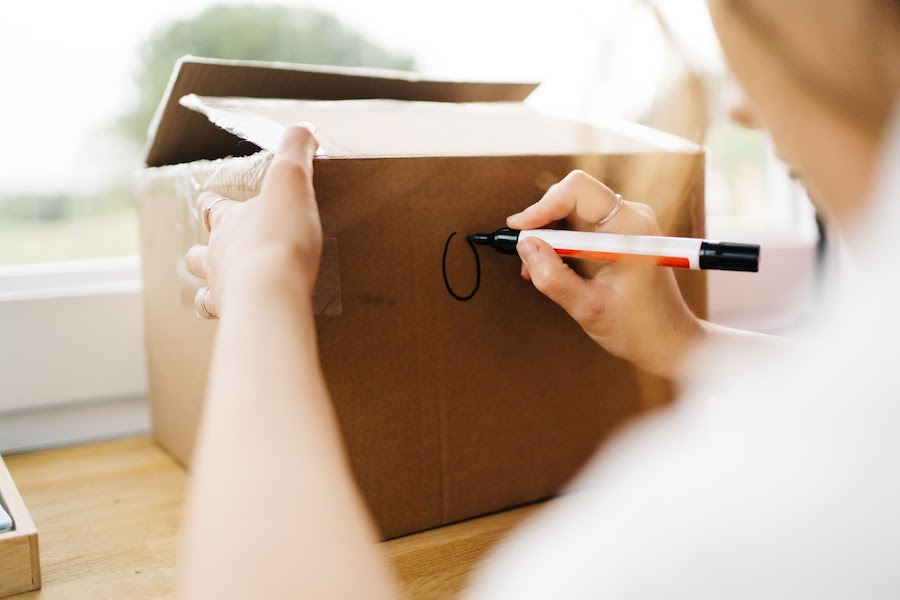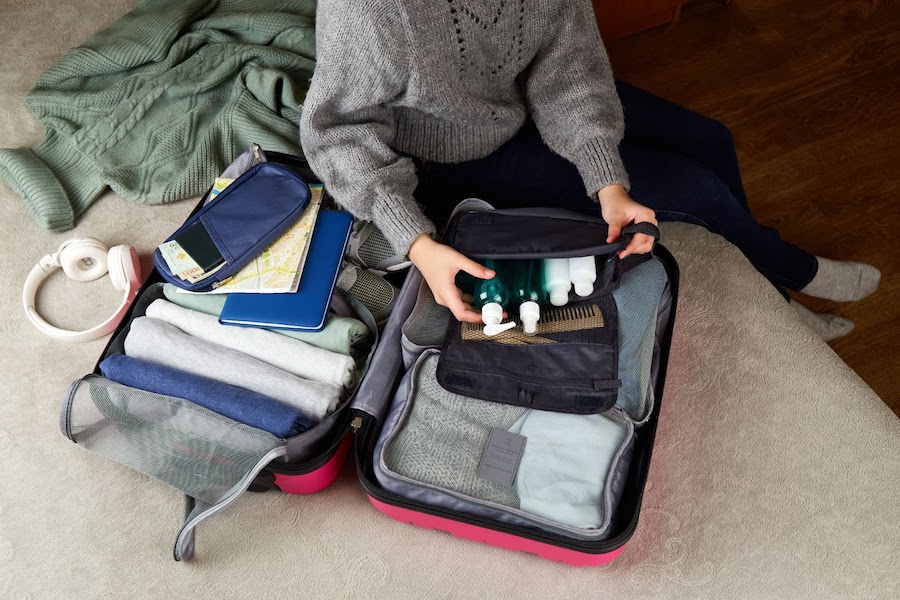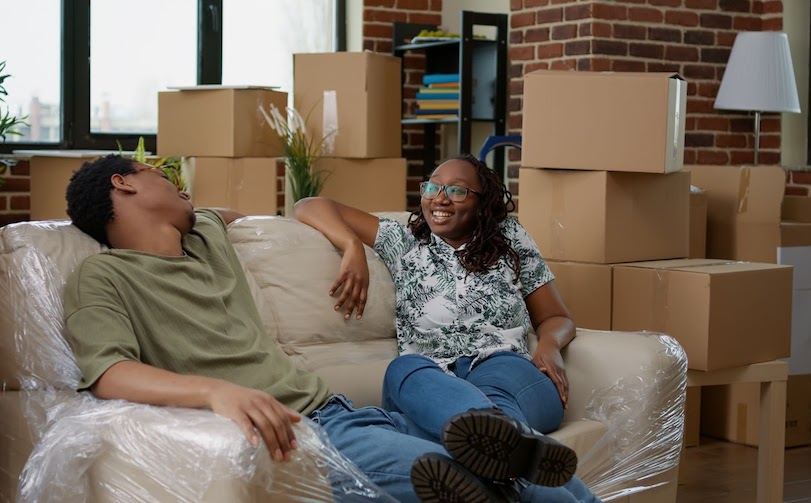We’ll just say it like it is: Moving can feel overwhelming. And for many people, one of the most overwhelming parts of the process is packing.
You’ve got to sift through everything you own and make (sometimes tough!) decisions about what goes with you to your new home… and what gets tossed or donated. But packing has a bright side: It’s also an opportunity for a fresh start, a chance to declutter, and maybe even rediscover some long-lost treasures!
Part of having a great moving experience is in how you pack. When packing is done well, it can save you time, money, and a whole lot of stress. As a professional moving company, we’ve got some packing tips for moving that can streamline the process. So let’s dive into how to pack — not just effectively, but like a seasoned moving pro!
Stay organized with our free, comprehensive Moving Checklist, designed to help you manage every step efficiently.

Planning and Preparation
1. Declutter Before Packing
Before you even unfold a packing box, take a good, thoughtful look through your items. Do you really need that old, dusty lamp? Are you ever going to wear those bell-bottom jeans again? If the answer is yes, awesome! But if the answer is no, it might be time to part ways with those items. Selling, donating, or tossing things you don’t need means you’ll have less to pack and less to worry about on moving day.
2. Creating a Packing Timeline
Now, let’s talk about strategy tips for packing and moving. In your home, you likely have items that you’ll need up until moving day and others that can be boxed far in advance. When you create a packing schedule, you can ensure that you don’t end up packing everything at the last minute. Spread out your packing over a few weeks, starting with items you won’t miss if they’re packed away early (like that fondue set you hardly ever use!).
3. Gathering Supplies
Before you start packing your boxes, you’ve got to have boxes (bubble wrap, tape, markers to label boxes, etc.)! As you’re gathering packing supplies, remember: You’ll probably need more than you think. Get yourself some strong boxes, several rows of packing tape, and enough bubble wrap to keep your fragile items safe.
Follow these tips for moving packing: Your stuff — and your future self — will thank you!

Packing Room by Room
1. Start With Least-Used Rooms
Tackling one room at a time keeps things manageable. Start with the rooms you use less often, like the attic or the guest room, and work your way to the more frequently used spaces.
2. Packing Tips for Each Room
Kitchen
In the kitchen, it’s important to wrap up all your breakables, from Grandma’s china to your coffee mug collection. Another of our packing tips for moving: There are special dish-packing boxes available to keep everything safe and secure.
Bedrooms
For bedrooms, consider using vacuum bags for clothes and linens. This is a great way to save space!
Living Room
Living rooms are often where many electronics, books, and knick-knacks are kept. As you’re packing your electronics, keep cords and items together — so you aren’t playing detective trying to match them up later! Books are heavy, so it’s best to use small boxes. Also, remember to pack books flat in order to protect their spines.
Bathroom
You can help prevent shampoo explosions in your boxes by securing products’ lids and wrapping bottles in plastic bags. This is a small step that can save you time cleaning up a big mess later.
One of our favorite packing for moving tips is to color-code your boxes! Choose a color for each room (for example, green for the living room). Place a label of that color on boxes for each room. That way, it’s easy-peasy to know where each box goes when you move in.
Packing Techniques

When it comes to packing boxes, the “hows” are important. Here are some things to remember:
Labeling Boxes
When you’re moving into your new home, labeled boxes will be your best friend. As you’re packing each room, make sure to label the room and contents of the box. If the box is heavy or has fragile contents, make sure to note that as well.
Use the Right Size Box
Now, about box size: It’s not just about what can fit into the box, it’s about weight as well. As you’re loading your boxes, keep heavier items in smaller boxes and lighter items in larger boxes. Heavy items (like books) should be packed in smaller boxes, while lighter items (like pillows) can go in bigger ones. Choosing the right size keeps boxes from becoming too heavy to lift (and prevents backaches!).
Weight Distribution
Another of our professional packing tips for moving: Make sure to distribute the weight evenly! A lopsided box is more likely to tip over or be challenging to carry.
Padding and Cushioning
As you’re packing, make sure that you use enough bubble wrap, packing peanuts, towels, or whatever you’re using for padding.
Efficient Box Filling
When you pack boxes efficiently, it minimizes damage to your belongings, conserves packing materials, and helps to avoid shifting contents. So fill those boxes up, but don’t overdo it. An overstuffed box could be an accident waiting to happen.
Specialized Packing Tips
As you pack your delicate belongings — like your collection of snow globes or that fancy digital camera — take your time and pack with care.
- Packing Fragile Items: Protect your glassware, dishes, electronics, and collectibles individually with bubble wrap or other padding. Double-boxing can also add a layer of protection.
- Packing Valuables: If possible, pack valuables like jewelry and important documents in small boxes that you can keep with you. That way, you have them when you need them.
- Packing Large and Bulky Items: For items like furniture, artwork, and appliances, packing can be a challenge. Some items can be disassembled for easier transport. Wrapping furniture in blankets or plastic can also help avoid dings and scratches.
What’s number one on our list of tips for packing and moving? A reliable moving company can help you with the moving process from start to finish!
Pro Packing Hacks
What about other packing hacks to make the process easier? We mentioned a few already, but here are some of our favs:
- Use Vacuum Bags for Clothing and Bedding: You can save space by using vacuum bags, giving you more room for your other belongings.
- Color-Coded Labels or Stickers: Color-coding can be a lifesaver when it comes time to unpack!
- Packing Cables and Electronics: Here’s a clever hack: You can use toilet paper rolls to keep your cords organized! It’s simple, effective, and you’re recycling! Win-win-win!
- Suitcases for Heavy Items: Wheeled suitcases aren’t just for travel — they’re also great for heavy items like books! And one of our packing tips for moving in a hurry: Toss those final items you’ll need on moving day into a rolling suitcase, and use it as your overnight bag.

Final Checks
Before you seal up the moving truck, do a final sweep:
- Double-Check Labels: Make sure each box is labeled correctly.
- Essentials Box: Pack a box with essentials you’ll need right away (clothes, toiletries, important documents).
- Review Your Inventory: Make sure all items are accounted for.
Take one last look at your inventory list. It’s better to catch a missing item now than when you’re halfway across the country.
What Tips Do Professionals Have For Packing?
Packing doesn’t have to be the bane of your moving experience. With a bit of planning, the right materials, and some pro packing tips for moving, packing can be just another step in the exciting journey to your new home. As we’ve been serving customers professionally for over a century, we know the difference these tips can make.
With a great moving partner by your side, you’ve got this!

FAQs
What’s the best way to pack fragile items?
- Wrap each item individually, use plenty of cushioning, and consider double-boxing the most delicate items. Label the box clearly as “Fragile” to ensure careful handling.
How long should I allow for packing before my move?
- Start packing non-essentials about three to four weeks before your move. You can tackle items you use often closer to moving day.
What packing supplies are essential for a successful move?
- Good-quality boxes, packing tape, bubble wrap, packing paper, markers for labeling, and specialty containers for delicate items are all must-haves for a successful move.






